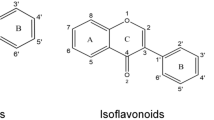Abstract
The composition of terpen lactones and flavonol glycosides of commercial preparation series based on Ginkgo biloba extracts was investigated by 1H NMR spectroscopy. The content of individual terpen lactones was determined using DMSO-d6 and acetone-d6 solvents. The effect of the structure of flavonol glycosides on the signal of the hydroxyl proton at a position 5 of the ring A was examined. A new approach was proposed for semiquantitative determination of the total amount of flavonol glycosides by the integral intensity of this signal, which is a superposition of the singlets in the region of 12.5–12.65 ppm of individual flavonoids in DMSO-d6. Since the corresponding signals of aglycones (quercetin, kaempferol, isorhamnetin), which are minor components of the Ginkgo biloba extracts, appear separately in a slightly different region (12.45–12.48 ppm), the proposed method can also be used for detecting adulteration of Ginkgo biloba extracts by means of the addition into them of relatively cheap aglycones or rutin as well as for assessment of the content of flavonoids of similar structure in some types of plant raw materials.
Similar content being viewed by others
References
Nakanishi, K., Terpene trilactones from ginkgo biloba: from the ancient times to the 21st century, Bioorg. Med. Chem., 2005, vol. 13, pp. 4987–5000.
Stromgaard, K. and Nakanishi, K., Chemistry and biology of terpene trilactones from Ginkgo biloba, Angew. Chem., Int. Ed., 2004, vol. 43, pp. 1640–1658.
Mahadevan, S. and Park, Y., Multifaceted therapeutic benefits of Ginkgo biloba L.: Chemistry, efficacy, safety and uses, J. Food Sci., 2008, vol. 73, no. 1, pp. R14–R19.
Gardner, C.D., Taylor-Piliae, R.E., Kiazand, A., Nicholus, J., Rigby, A.J., and Farquhar, J.W., Effect of Ginkgo biloba (EGB 761) on treadmill walking time among adults with peripheral artery disease: A randomized clinical trial, J. Cardiopulm. Rehabil. Prev., 2008, vol. 28, pp. 258–265.
Krylova, N.N., Kompantseva, E.V., and Shevchenko, A.M., Substantiation of the composition and methods of analysis of sublingual pills on the basis of extracts of ginkgo, dropwort, glycine, and succinic acid, Razrab. Registr. Lekarstv. Sredstv, 2015, no. 1 (10), pp. 84–91.
Agnolet, S., Jaroszewski, J.W., Verpoorte, R., and Staerk, D., 1H NMR-based metabolomics combined with HPLC-PDA-MS-SPE-NMR for investigation of standardized Ginkgo biloba preparations, Metabolomics, 2010, vol. 6, no. 2, pp. 292–302.
Liu, X.G., Wu, S.Q., Li, P., and Yang, H., Advancement in the chemical analysis and quality control of flavonoids in Ginkgo biloba, J. Pharm. Biomed. Anal., 2015, vol. 113, pp. 212–225.
Okabe, K., Yamada, K., Yamamura, S., and Takada, S., Ginkgolides, J. Chem. Soc., 1967, pp. 2201–2206.
Weinges, K., Hepp, M., and Jaggy, H., Isolierung und Structuraufklarung eines neuen Ginkgolids, Liebigs Ann. Chem., 1987, no. 6, pp. 521–526.
Weinges, K. and Bahr, W., Bilobalid A, ein neues Sesquiterpen mitt ret-Butyl-Gruppe aus den Blattern von Ginkgo biloba L., Liebigs Ann. Chem., 1969, pp. 214–216.
Nakanishi, K., Habaguchi, K., Nakadaira, Y., Woods, M.C., Maruyama, M., Major, R.T., Alauddin, M., Patel, A.R., Weinges, K., and Bahr, W., Structure of bilobalide, a rare tret-butyl containing sesquiterpenoid related to the C20-ginkgolides, J. Am. Chem. Soc., 1971, vol. 93, pp. 3544–3546.
Van Beek, T.A., van Veldhuizen, A., Lelyveld, G.P., Prion, I., and Lankhorst, P.P., Quantitation of bilobalide and ginkgolides A, B, C, J by means of nuclear magnetic resonance spectroscopy, Phytochem. Anal., 1993, vol. 4, pp. 261–268.
Farmakopeya SShA: USP 29 (13. United States Pharmacopoeia: USP 29), in 2 vols., Moscow, 2009, vol. 1.
European Pharmacopoeia, 6th ed., Strasbourg: European Department for the Quality of Medicines. 2007.
China Pharmacopoeia Commission, Pharmacopoeia of People’s Republic of China, The First Division of 2010 Edition, Beijing: China Medical Science Press, 2010, vol. 1, pp. 296–297.
Li, Ch.Y., Lin, Ch.H., Wu, Ch.Ch., Lee, K.H., and Wu, T.Sh., Efficient 1H nuclear magnetic resonance method for improved quality control analyses of ginkgo constituents, J. Agric. Food Chem., 2004, vol. 52, pp. 3721–3725.
Napolitano, J.G., Godecke, T., Rodrigues-Brasco, M.F., Jaki, B.U., Chen, Sh.N., Lankin, D.C., and Pauli, G.F., The tandem of full spin analysis and qHNMR for the quality control of botanicals exemplified with Ginkgo biloba, J. Nat. Prod., 2012, vol. 75.
Charisiadis, P., Kontogianni, V.G., Tsiafoulis, C.G., Tzakos, A.G., Siskos, M., and Gerothanassis, I.P., 1HNMR as a structural and analytical tool of intra-and intermolecular hydrogen bonds of phenol-containing natural products and model compounds, Molecules, 2014, vol. 19, pp. 13643–13682.
Sheichenko, V.I., Sheichenko, O.P., Anufriev, V.V., Tolkachev, O.N., Dyumaev, K.M., and Sokol’skaya, T.A., Study of the phenolic component of plant metabolomol by NMR, Khim.-Farm. Zh., 2016, vol. 50, no. 2, pp. x51–57.
Gray, D.E., Upton, R., Chandra, A., Porter, A., and Harris, R.K., Quantitative analysis of flavonol glycosides in Ginkgo biloba: a comparison of two analytical methods, Phytochem. Anal., 2006, vol. 16, no. 1, pp. 56–62.
Author information
Authors and Affiliations
Corresponding author
Additional information
Original Russian Text © V.G. Vasil’ev, A.S. Prokop’ev, G.A. Kalabin, 2016, published in Khimiya Rastitel’nogo Syr’ya, 2016, No. 3, pp. 85–93.
Rights and permissions
About this article
Cite this article
Vasil’ev, V.G., Prokop’ev, A.S. & Kalabin, G.A. Identification of Terpene Lactones and Flavonol Glycosides in Preparations Based on Ginkgo Biloba Extract and a New Way of Semi-Quantitative Determination of Flavonol Glycosides by 1H NMR Spectroscopy. Russ J Bioorg Chem 43, 776–782 (2017). https://doi.org/10.1134/S1068162017070172
Received:
Accepted:
Published:
Issue Date:
DOI: https://doi.org/10.1134/S1068162017070172




